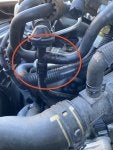Hi friends!
I just got back from a year-long trip. The Audi has been parked outside. Battery died, and I had a hard time getting it to start (old fuel maybe?).
Once the car started, the engine struggled quite a bit. It shook. Seemed like there was some misfiring going on.
But once the car warmed up, all was well. I fueled up with new gas and have been driving no problem.
I checked VCDS.
There were some fault codes....mostly associated with the low-voltage of a dying battery.
A few faults regarding cylinder misfire and the engine running too lean.
I cleared them and they've never returned.
But now I'm stuck.
One fault remains. It won't go away. I clear the codes and then....it's back. So I'm thinking there is an actual issue somewhere.
Can anyone please advise me what I need to check?
NOTE: (Date is incorrect in the report, because I didn't adjust the onboard clock. The date should say 2021.02.11)
Fault Found:
008825 - Leak in Air Intake System
P2279 - 002 -
Freeze Frame:
Fault Status: 01100010
Fault Priority: 2
Fault Frequency: 1
Reset counter: 255
Mileage: 94578 km
Time Indication: 0
Date: 2021.02.01
Time: 21:04:57
Freeze Frame:
RPM: 760 /min
Load: 14.9 %
Speed: 0.0 km/h
Temperature: 71.0°C
Temperature: 31.0°C
Absolute Pres.: 1010.0 mbar
Voltage: 14.224 V
Readiness: 0110 0101
I just got back from a year-long trip. The Audi has been parked outside. Battery died, and I had a hard time getting it to start (old fuel maybe?).
Once the car started, the engine struggled quite a bit. It shook. Seemed like there was some misfiring going on.
But once the car warmed up, all was well. I fueled up with new gas and have been driving no problem.
I checked VCDS.
There were some fault codes....mostly associated with the low-voltage of a dying battery.
A few faults regarding cylinder misfire and the engine running too lean.
I cleared them and they've never returned.
But now I'm stuck.
One fault remains. It won't go away. I clear the codes and then....it's back. So I'm thinking there is an actual issue somewhere.
Can anyone please advise me what I need to check?
NOTE: (Date is incorrect in the report, because I didn't adjust the onboard clock. The date should say 2021.02.11)
Fault Found:
008825 - Leak in Air Intake System
P2279 - 002 -
Freeze Frame:
Fault Status: 01100010
Fault Priority: 2
Fault Frequency: 1
Reset counter: 255
Mileage: 94578 km
Time Indication: 0
Date: 2021.02.01
Time: 21:04:57
Freeze Frame:
RPM: 760 /min
Load: 14.9 %
Speed: 0.0 km/h
Temperature: 71.0°C
Temperature: 31.0°C
Absolute Pres.: 1010.0 mbar
Voltage: 14.224 V
Readiness: 0110 0101










